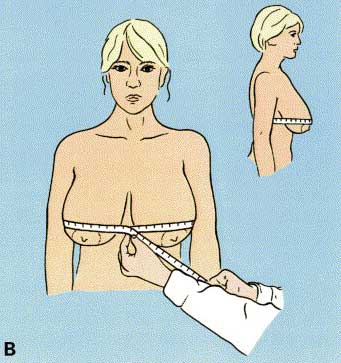|
Cup Size Measurement Guide
|
|
|
Measuring the cup size is trickier; even with a measurement it is better to try on different bras and find out experimentally which one fits.
Have someone measure you again, this time the measuring tape goes on top of the fullest part of your breasts. If you already own a well-fitting non-padded bra, you can wear it while taking this measurement as long as it doesn't 'flatten' your breasts (which would make an illusion of a smaller cup size). Record this number, and find the difference between that, and the band-size number. The difference tells you the correct cup size as follows:
|
Difference:
(inches)
|
negative
|
< 1
|
1"
|
2"
|
3"
|
4"
|
5"
|
6"
|
7"
|
|
Cup size
|
AAAA or AAA
|
AA
|
A
|
B
|
C
|
D
|
DD or E
|
DDD or F
|
DDDD or G
|


While this chart is useful for determining the cup size, bear in mind that 34A cup does NOT have the same exact volume as 36A or 38A. Similarly, 30D does not have the same volume as 36D (30D is a much smaller cup than 36D). So, if you try on a 36B bra and the cup size fits but the band is too loose so that you decide to go to down in band size to 34, you may actually need 34C cup size so as to have about the same volume in the bra cup.
This is sort of counter-intuitive. Just remember to go by the fit, not by the numbers. You have to try the bra on. If it fits right, that's your bra size even if the tape measure told you different.
|

|
The correct cup size should be completely filled out with no wrinkling of the fabric or space in the cups, but any spillage or "double boob" means the cup size is too small, even in low cut or pushup bras.
Measure loosely around the fullest part of your bust, holding the tape measure straight but not tight. Subtract your band size from this measurement.
The result would be YOUR REGULAR BRA SIZE. If the difference is
less than 1 inch to 1 inch = A cup
2 inches = B cup
3 inches = C cup
4 inches = D cup
5 inches = DD cup
For example: If your band size is 34" and your bust measurement is 35", you wear an "A" cup.
|
There are two elements to your bra size; the band size (ie. 32, 34, 36) and cup size (ie. A, B, C). You will need a measuring tape to determine your bra size.
Using a soft tape-measure, measure around the ribcage directly under the bust. Be sure the tape is smooth across the back and level with the front.
Add 5 to this measurement to obtain your band size.
For example: If your ribcage measurement is 29" + (5) = 34" band size. If the resulting band size is an odd number like 33", you can usually go to the next even band size (34").
 
Since everyone's breasts are different in terms of shape (even between your own breasts), the most accurate way to determine your cup size is by using your current bra size as a starting point. The cups are sized relative to the band, so if you were to try a smaller band size but keep the same cup size, the cups would be too small.
For every band size you have dropped, you will need to increase the cups by one size. For example, if you are currently wearing a 34D bra, and you measure 28 inches, you should probably wear a 28F.
The majority of leading brands use UK cup sizing: AA, A, B, C, D, DD, E, F, FF, G, GG, H, HH, J, JJ, K, KK, L, LL. If you're shopping in the US you might see cup sizes such as DDD or DDDD. These are equivalent to E and F. If you're in any doubt, particularly with larger cup sizes, you can refer to an international bra sizing chart
|
|
|
|
|
|
|
|
|
|